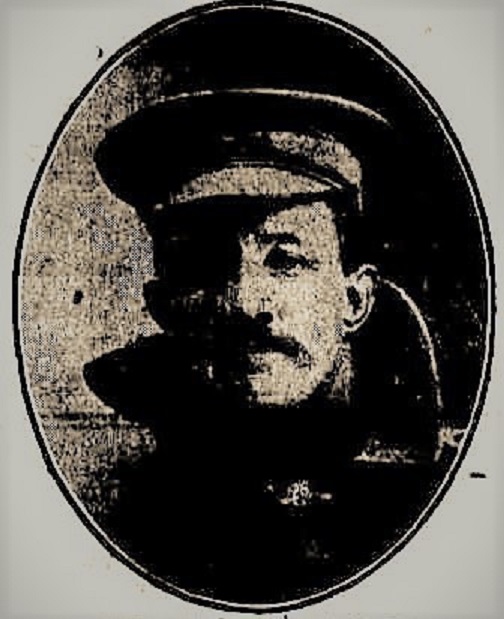18th BATTALION - 35th BATTALION AIF
Private: 6859 Theodore TREGLOWN.
Born: 1880. Hartley Vale, New South Wales, Australia. Birth Cert:16051/1880.
Married: 1914. Lithgow, New South Wales, Australia. Marriage Cert:2058/1914.
Wife: Alice Gertrude Treglown. nee: Barker. Alice re married in 1921 to Thomas S Austin at Canterbury, N.S.W. Marriage Cert:6606/1921.
Died: 6th May 1918. Killed in Action at Morlancourt, France.
Father: Joseph Treglown. (1839-1901) Died at Lithgow, New South Wales, Australia.
Mother: Alice Broad Treglown. nee: Tregloan. (1837-July 1919) Died at Lithgow, New South Wales, Australia.
INFORMATION
Theodore Treglown enlisted with the AIF on the 18th May 1917 at Lithgow, New South Wales, Australia where he was allocated to the 20th Reinforcements, 18th Battalion. Theodore en trained to Sydney before being transported to the Menangle Park Training Squadron on the 6th June as a Trooper and embarked from Sydney on board HMAT A72 "Beltana" on the 16th June 1917. Whist at seas, Theodore was admitted to the Ships Hospital suffering from Influenza. He was treated by the Ships Doctor and after a few days of rest and medicine he was discharged on the 7th August 1917.
Theodore disembarked at Plymouth England on the 25th August and was marched in the the 5th Training Battalion at Rollestone where they settled down to hard training, which included Route Marching, Trench Digging, Bomb Practice, Musketry and General Camp Routine.

Rollestone Camp, Salisbury Plain.
Theodore proceeded overseas for France via Southampton on the 1st January 1918 and after disembarking went into billets before being marched out to their units on the 5th of January when Theodore was transferred to and Taken on in Strength with C Company No: XI Platoon, 35th Battalion AIF on the 7th January 1918.
30th March 1918
2:00 am, Arrived at CACHY and billeted in Aerodrome. 9:00 am, assembled for counter-attack and remained in formation till 5:00 pm then returned to billets. 10:00 pm, received instruction to move into the line.
(35th Battalion Diary)
4th-5th April 1918
The First VILLERS-BRETONNEUX
The Strength of the 9th Infantry Brigade was about 2,250 but their casualties during the 2 days of fighting numbered 30 Officers and 635 men either killed in action or missing.
9th Infantry Brigade Casualties.4th-5th April 1918
| 33rd Battalion. AIF | 3 Officers | 82 Other ranks |
| 34th Battalion. AIF | 5 Officers | 120 Other ranks |
| 35th Battalion. AIF | 9 Officers | 282 Other ranks (including 44 missing) |
| 36th Battalion. AIF | 12 Officers | 133 Other ranks (including 1 missing) |
| 9th Machine Gun Company. AIF | 1 Officer | 18 Other ranks (including 4 missing) |
16th April 1918.
’On the 16th April, the rumours of a new German Offensive against Amiens seemed to be definitely confirmed. A German prisoner, taken by the French, volunteered the that Villers Bretonneux was to be attacked the next day. The 5th Australian Division, which had come line on the night of the 6th/7th April, and held the sector from Villers Bretonneux (inclusive) to the Somme canal was warned to be ready to retake the town, if captured by attack from the north ; and other preparations and counter-preparations were made. About 4 A.M. on the 17th, Villers Bretonneux, Bois d'Aquenne, to the west of it and the village of Cachy, to the south, were heavily drenched for three hours with phosgene, mustard and irritant gasses. But no assault followed. As soon as possible the local garrison, consisting of the 6/London(58 Devon) and the 33rd Australian Battalion, was got out of the shelters in the town into the trenches around it. The gas shelling was repeated in the evening from 4 to 7 P.M., next morning and on the following days, being increased so as to include Bois I'Abbe, but with greatly reduced results. Nevertheless it was impossible for anyone to move that area without feeling some ill-effects from the mustard gas, and there were, in all, 1,074 gas casualties.’
’The gassing of Villers Bretonneux seemed to point to the probability of its not being attacked, but by this time air photographs had revealed the signs of imminent operations; an increase in the number of enemy batteries had also been noticed, while the roads were being registered by German artillery. There were, however, also indications that the Albert sector might be the objective of an attack which might extend to Arras and Vimy Ridge. On the 21st there was much air fighting near the Somme, and the famous airman Richthofen was brought down.1. That night a man of the 4th Guard Division, captured by the 8th Dvn , disclosed the fact that his formation had just relieved the 9th Bavarian Reserve Division in front of Marcelcave , and would attack Villers Bretonneux at 3 A.M. on the 23rd. Counter-preparations were continued, and the German railway centers were bombed, particularly Chaulnes .2 'No infantry assault materialized on the 23rd, two deserters came in from the 77th Reserve Division, just arrived from Russia, which had entered the line on 20th, south of the 4th Guard Division, opposite Cachy, and the French captured a gunner of the Guard Ersatz Division opposite Hangard. All these men said that the relief of the line divisions by " storm " divisions had been completed the infantry were ready to advance; the bombardment would begin early on the 24th and. last two and-a -quarter hours: and the attack would be assisted by new German tanks, which were already in position near the front line. It is from the fact that tanks were used to punch a hole in the British line on either side of Villers Bretonneux, and that, in consequence, the Germans gained possession of the town and ground on either side for a short time, that the fighting on the 24th derives its interest.’
24th April 1918.
3:30 am Heavy Bombardment heard on front. 10:30 am Instructions received to be ready to move immediately. 12:00 noon Instructions are now to move on 1 hours notice. Enemy attacked at Villers-Bretonneux at 6:30 am and at 1:00 pm. Was in position of the town and the ground to the South as far as HANGARD. By midnight the 13th and 15th Brigades and re taken the lost ground and captured 1200 Prisoners, 100 Machine Guns and 2 Field Guns.
25th of April 1918.
"Dull in the morning, but fine in the Afternoon. Owing to most of the fit men being on guard or other duties, no parade was held. A number of men are still sick with gas. Enemy seems to be very quiet on this front. Further South at Villers-Bretonneux the 15th Brigade, A.I.F who counter-attacked last night repulsed a strong enemy counter-attack. The counter-attack was very successful, the captures being roughly 1000 prisoners, 100 machine-guns, a field gun and 2 tanks. This is the first time we have heard of the enemy using tanks."
(35th Battalion War Diary)
5th-6th May 1918.
MORLANCOURT
A considerable success had been won-except on the two edges of the plateau, both lines of enemy trench had been captured on a front of three-quarters of a mile, and 153 prisoners (including 3 officers), 10 machine-guns, and 3 trench-mortars had been taken at the cost of only some 100 casualties, mostly minor ones.
The 35th lost 5 officers and 47 of other ranks, the 34th 2 officers and 32 other ranks. Lieutenant: 1124 William Henry GLOSSOP (Aberdare. N.S.W.) of the 35th was killed just after crossing the first trench.
Captain: Charles Edwin Woodrow BEAN Volume VI page 82.
Theodore was Killed in Action on the 6th May 1918 at Morlancourt and is remembered in perpetuity at the Commonwealth War Graves Commission at the HEILLY STATION CEMETERY - WAR MEMORIAL. Mourlancourt, Villlers-Brettoneux France.
Lithgow Mercury 29th May 1918
KILLED IN ACTION
PTE. THEO. TREGLOWN.
On Tuesday night Mrs. Theodore Treglown, of Corney Town, received a wire front Col. Sandford to the effect that her husband, Pte. "Theo.'' Treglown, was killed in action in France on the 6th instant. The deceased soldier, who was 38 years of age, was born at Hartley Vale, and had lived all his life in Lithgow and district. He had nearly a year's experience in the war zone, and prior to enlisting was employed in the Zigzag colliery. The late Pte. Treglown was highly respected and deservedly popular among a large circle of friends. The widow, mother, sister and three brothers (one of whom is now at the war); will have the sympathy of the community in their bereavement.
14th August 1918.
Informant: Sergeant: 2133 Henry RANDALL C Company No: 11 Platoon, 35th Battalion AIF. "I Knew him well. He cam from Lithgow, N.S.W. and had been a miner. He was a big chap. About the 5th May we were in front of Morlancourt, and attacked in the morning. Private: 6859 Theodore TREGLOWN was killed during the attack by a Machine Gun bullet in the side and died at once. I buried him in the open just behind the trench and I gave the Padre the map reference.
Australian Convalescent Depot
Rouelles, France.
27th August 1918.
Informant: Private: 1936 George Victor STANLEY. C Company 35th Battalion AIF. "Private: 6859 Theodore TREGLOWN was in C Company and he was killed at Morlancourt by a shell whilst taking prisoners back behind the line. Death was instantaneous. I knew him fairly well and I saw his grave at Small Ridge near Morlancourt on the field. The grave was marked by a little white cross having full details marked thereon. I cannot refer you to anyone for particulars of casualty.
3rd Australian Auxiliary Hospital
Dartford, England.
18th September 1918.
Informant: Reverend: John Edward Norman OSBORN. "Re Private: 6859 Theodore TREGLOWN of the 35th Battalion AIF. He was killed in action on May 5th. The Battalion attacked a German position on that day, near Morlancourt (between the Somme and the Ancre) by shell fire. His body was buried by the Battalion in the field."
London.
4th October 1918.
Informant: Sergeant: 1871 William STANLEY. C Company 35th Battalion AIF. "Re Private: 6859 Theodore TREGLOWN who was killed in action on May 6th 1918, when his unit was in action. He was buried in the field but I can give you the map reference is 62D.N.E.K.13a.10.95. a Padre was present at his burial and a cross has been erected by his battalion. His age would be between 37 to 39 years, tall and big built. He was rather a hearty sort of chap and was respected by all his company and I must say he was a good soldier both in and out of the line."
AIF France.
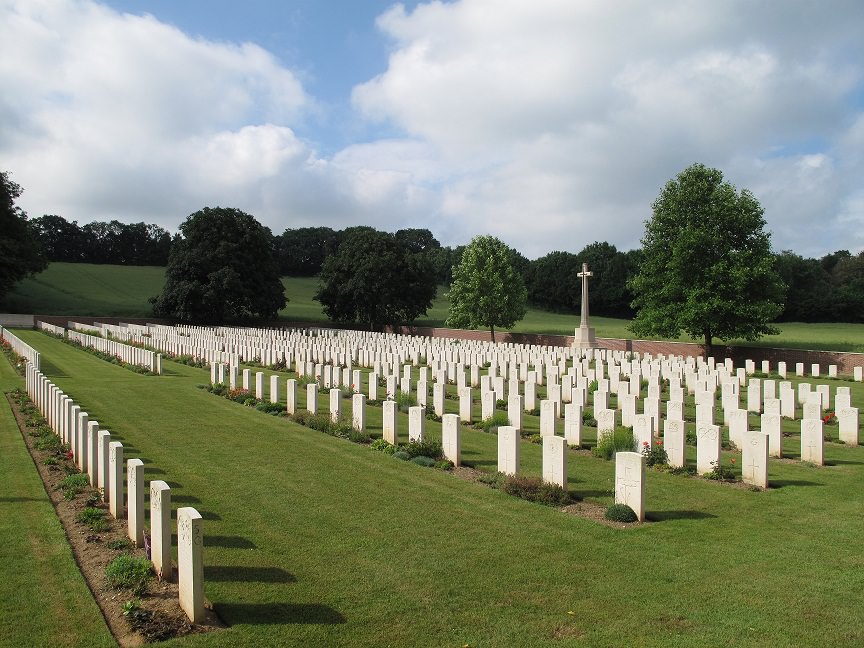
HEILLY STATION CEMETERY - WAR MEMORIAL. Mourlancourt, Villlers-Brettoneux France
 S.S. BARUNGA
S.S. BARUNGA
Friday 19 July 1918.
The Argus (Melbourne, Victoria)
LONDON, July 17. 1918.
S.S. BARUNGA SUNK. ON WAY TO AUSTRALIA. Passengers and Crew Saved.
The steamer Barunga has been sunk while on a voyage to Australia. Only one casualty has been reported. Former German Steamer the Navy Office announced yesterday that the Barunga was torpedoed in English waters on July 16. The passengers and crew, it was added, have been landed, so far as could be ascertained, without casualties. The Barunga was formerly the Sumatra, a well known unit of the German Australian Line. She was launched in June 1913, at Flensburg, Germany, and was one of a group of steamers which at that time were regarded as being unsurpassed in the world as cargo carriers, each of them having a capacity for 12,000 tons of general freight, and possessing engines capable of developing a speed of over 13 knots. When the war broke out the Sumatra was discharging at Sydney, and was seized by the Commonwealth authorities. She was renamed the Barunga, and since has been employed continuously as a transport and a cargo carrier.
Family Information
Theodore was a married 36 year old Coal Miner at the Zig Zag Colliery and lived at Corney Town, Lithgow, N.S.W. upon his enlistment with the AIF. Brother Samuel Henry Treglown, born Hill End via Bathurst, N.S.W. Birth Cert:22309/1878
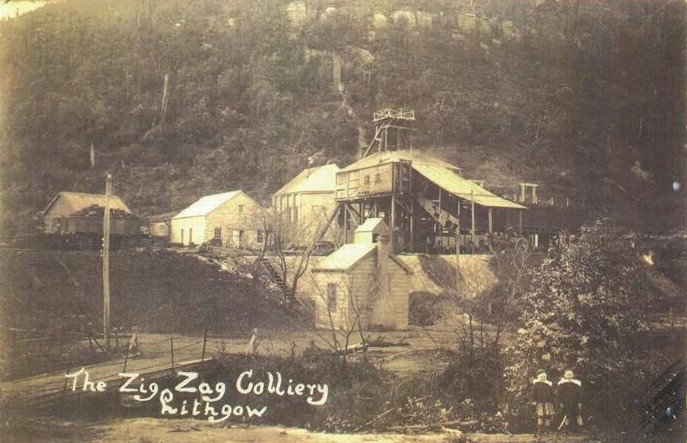
Zig Zag Colliery, Lithgow, New South Wales.
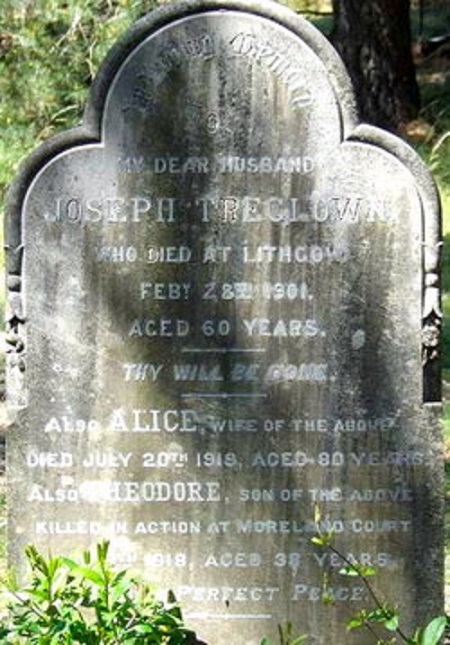
Grace of Joseph and Alive Stanley. Bowenfels, Old Presbyterian Cemetery
My dear husband Joseph Treglown who died at Lithgow Feb 28th, 1901 aged 60 years. Thy Will be Done. Also, Alice, wife of the above died July 20th, 1919 aged 80 years. Also, Theodore, son of the above, killed in action at Moreland Court May 6th, 1918, aged 35 years.
Hi David, doing some research on my partners Great Uncle, 6859 Pte Theodore Treglown, 35th Bn, KIA 6 May 1918. His records show he was killed at map reference sheet 62D NEK 13a, what does this mean and can it located today?
Regards,
Andrew Bailey: May 2022.
Military Records
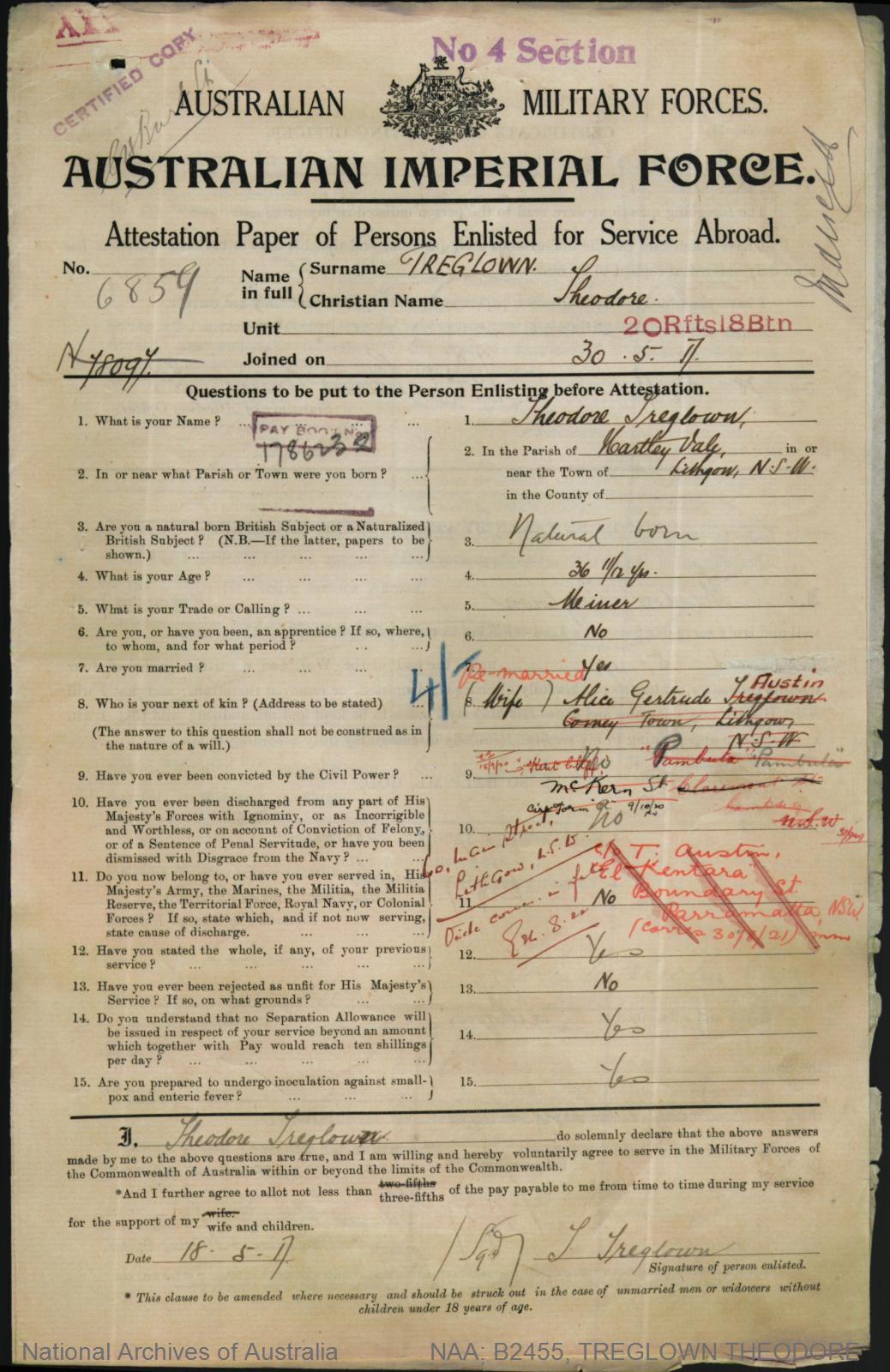

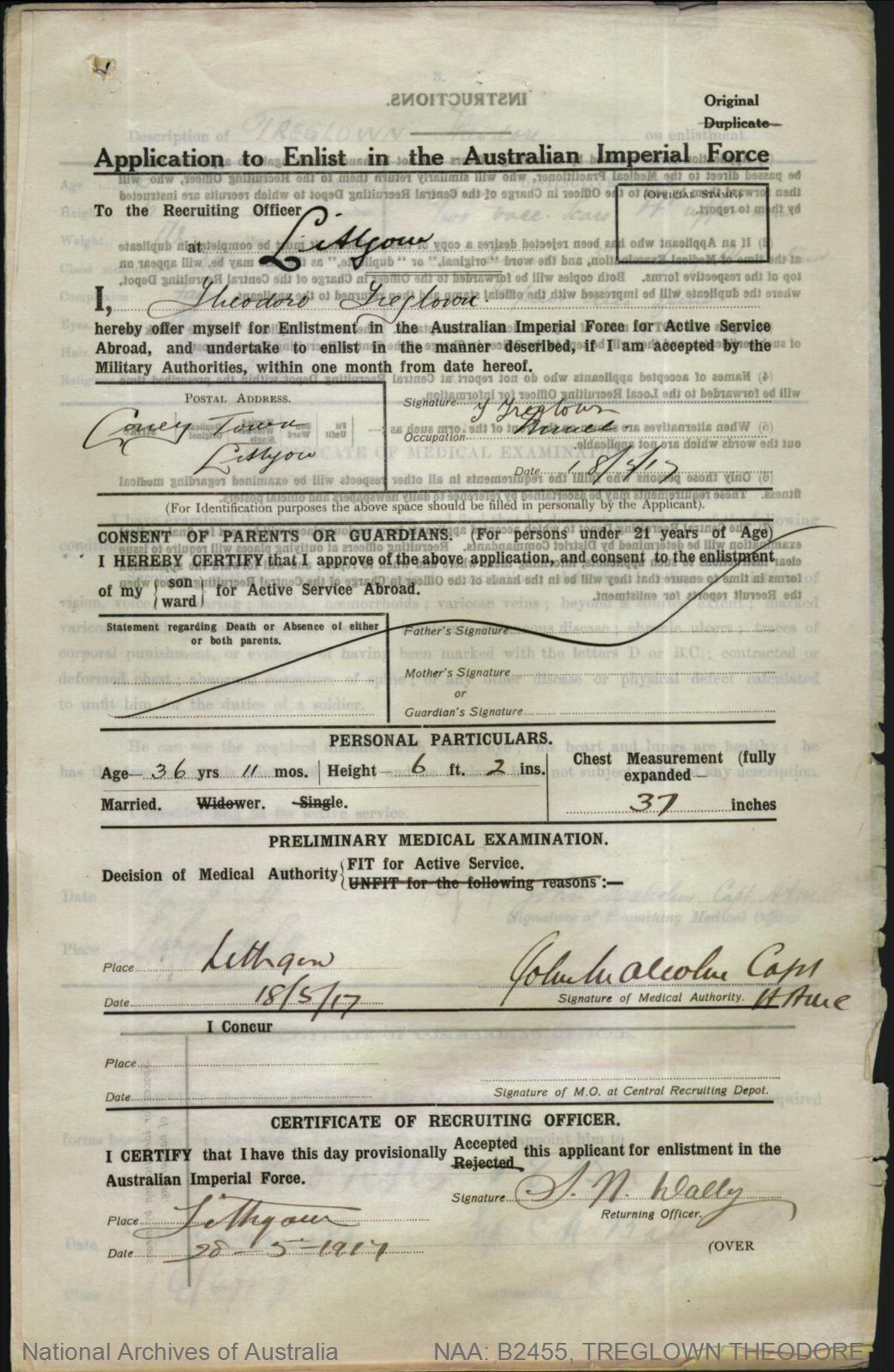

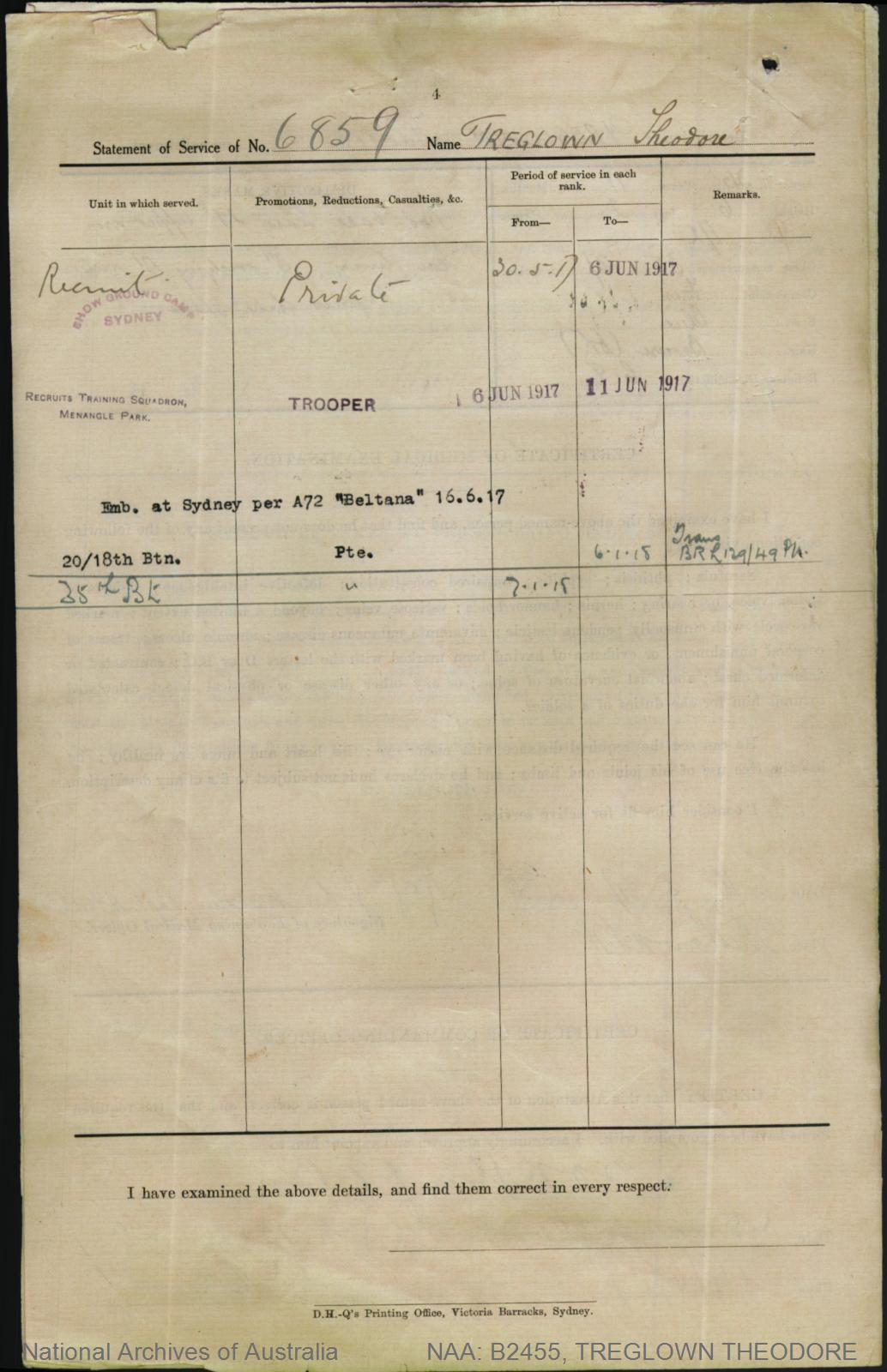

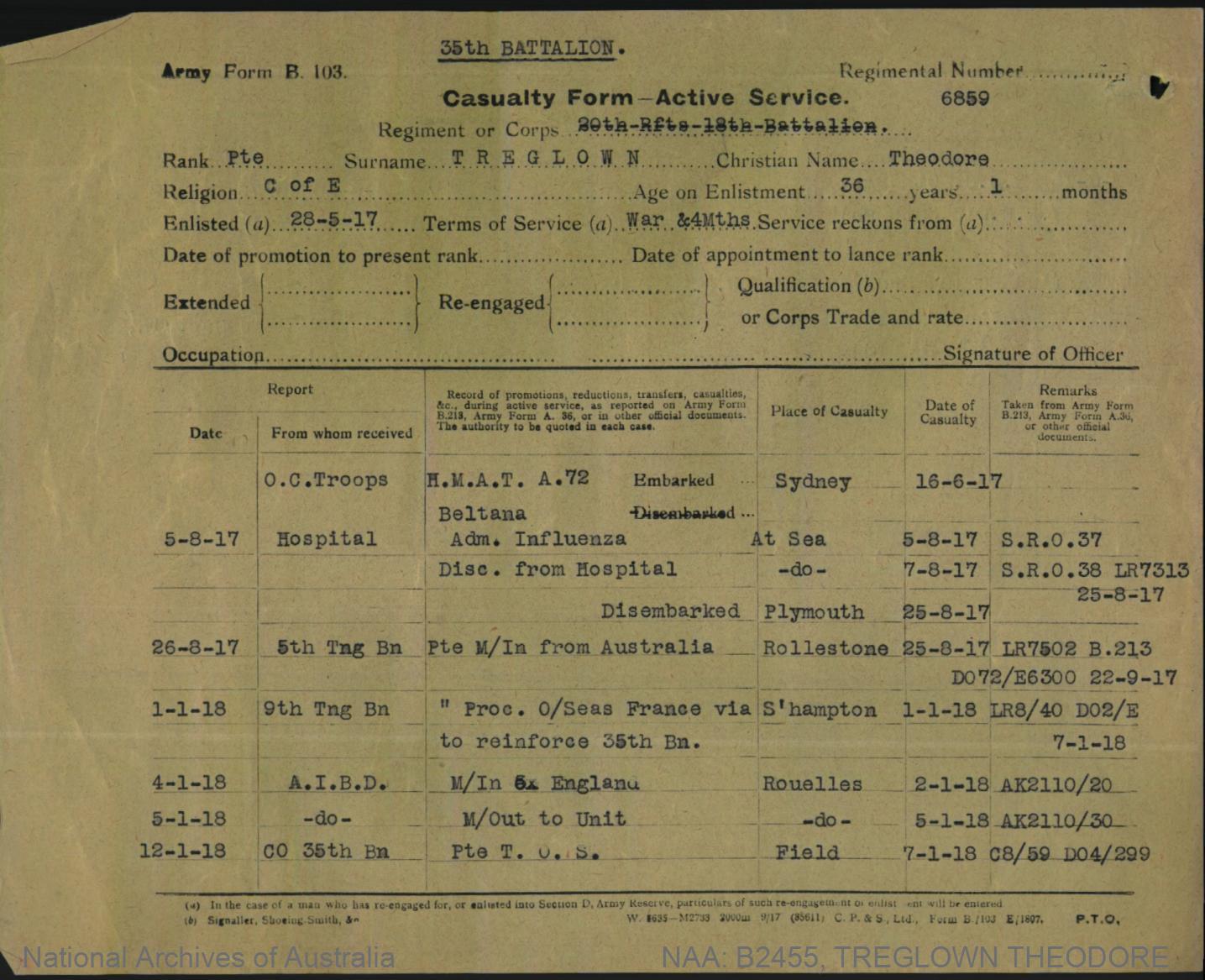
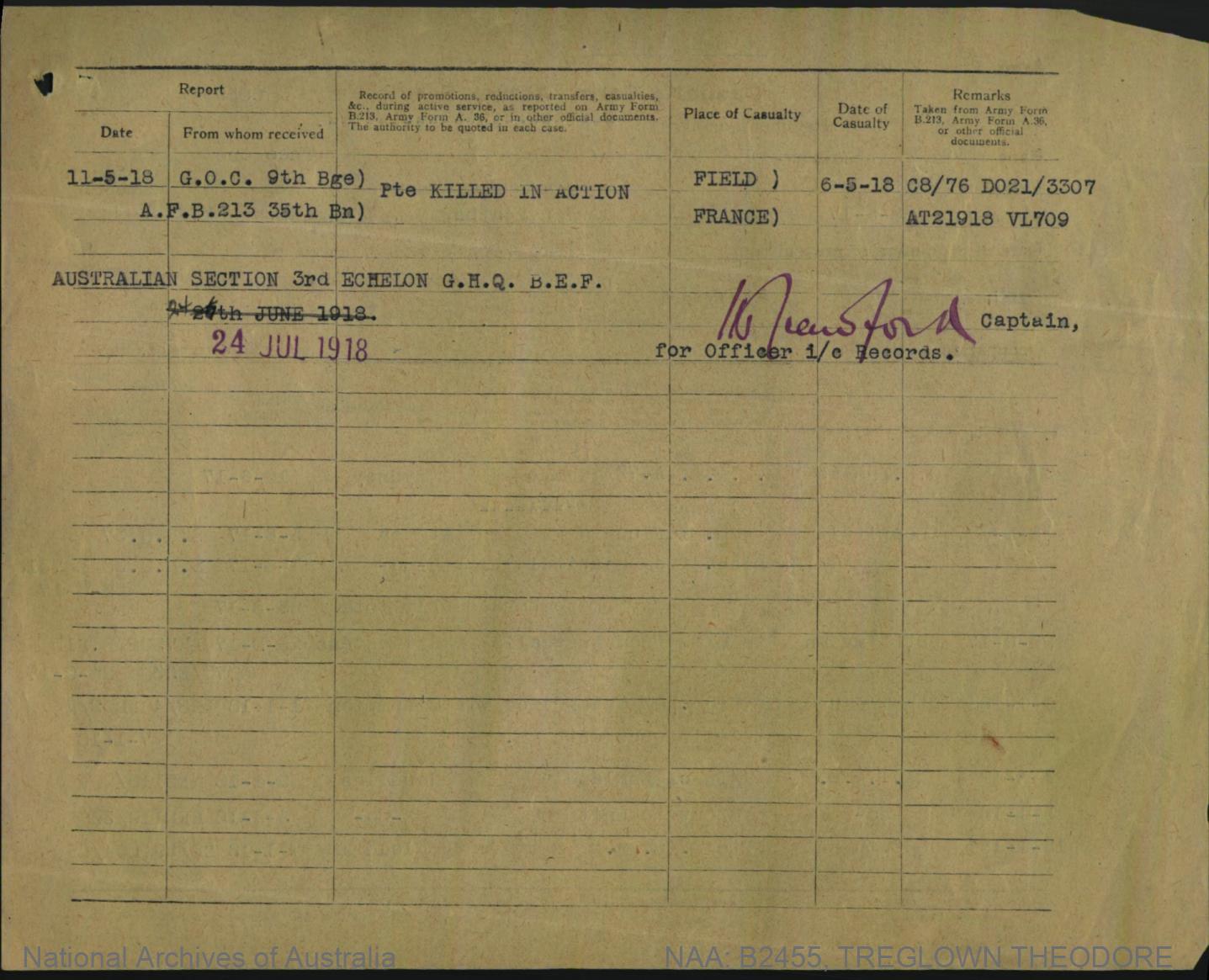
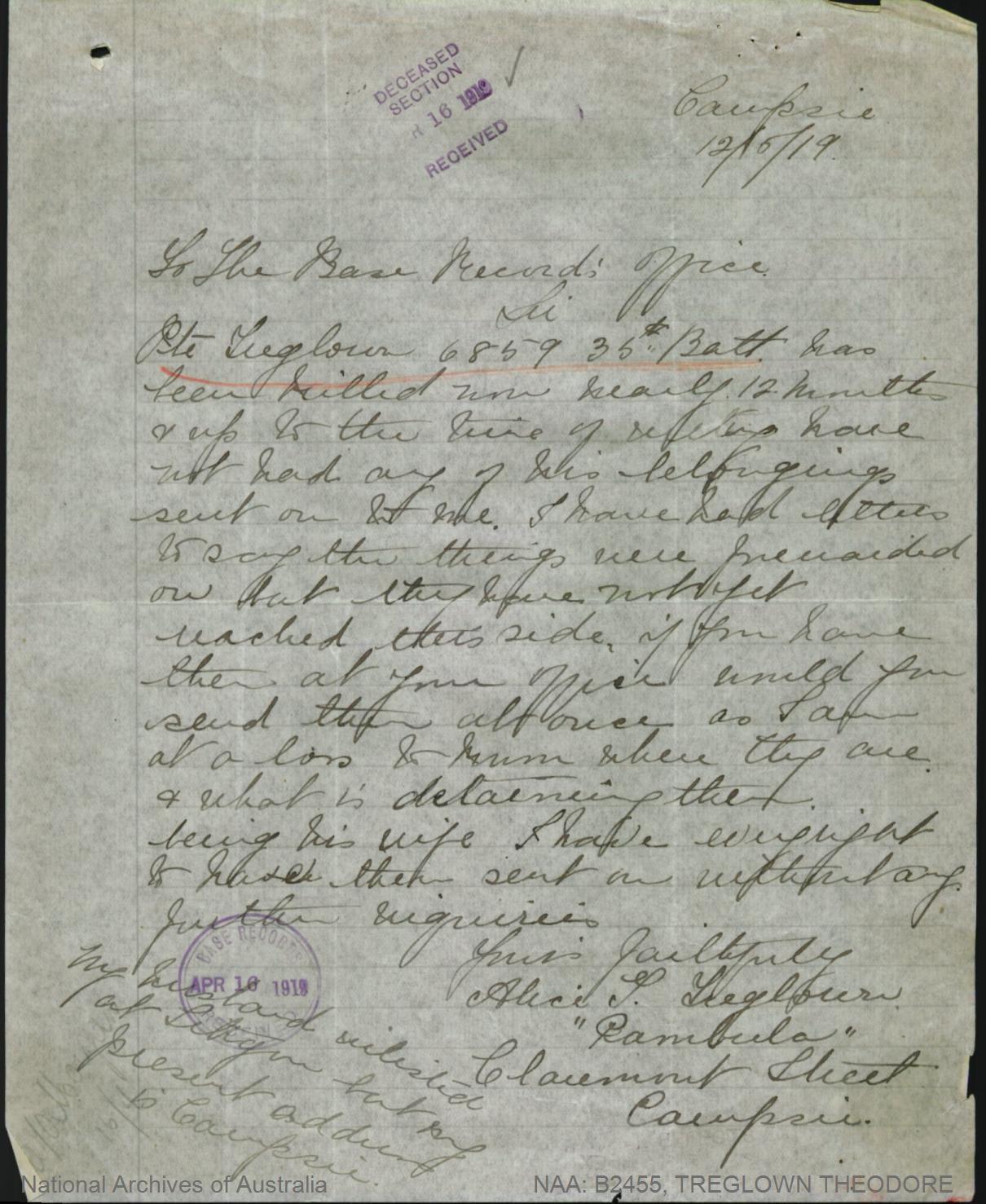

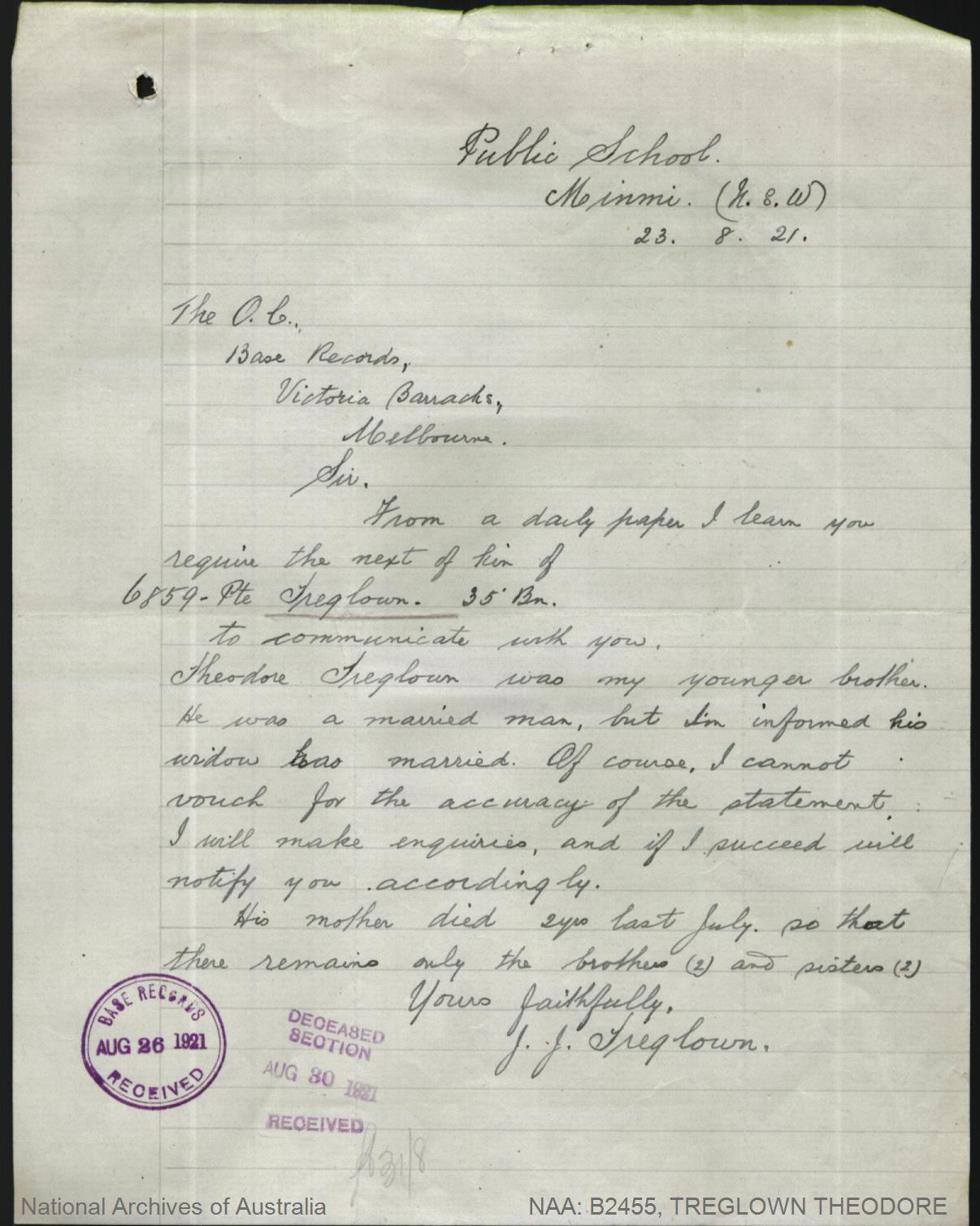
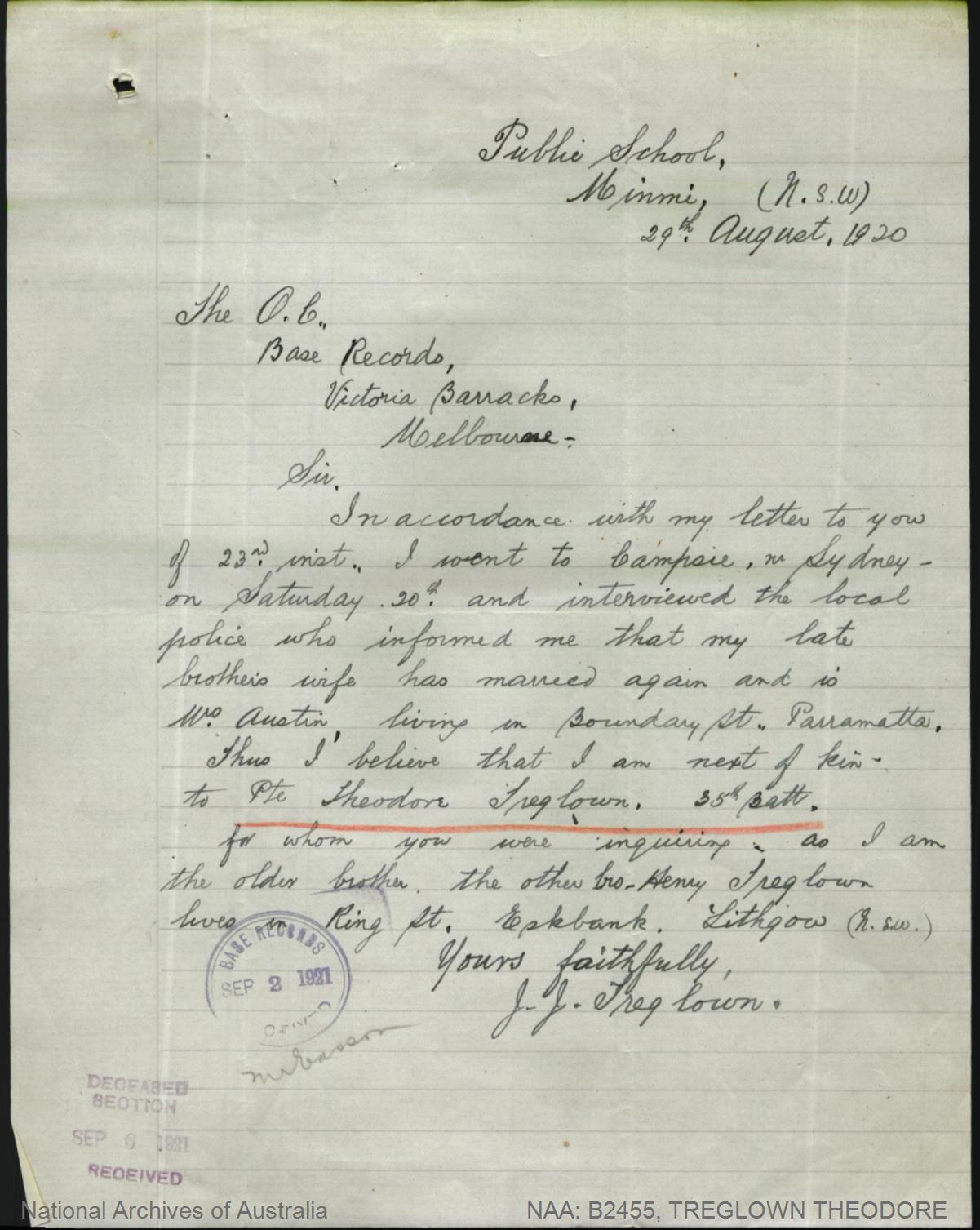
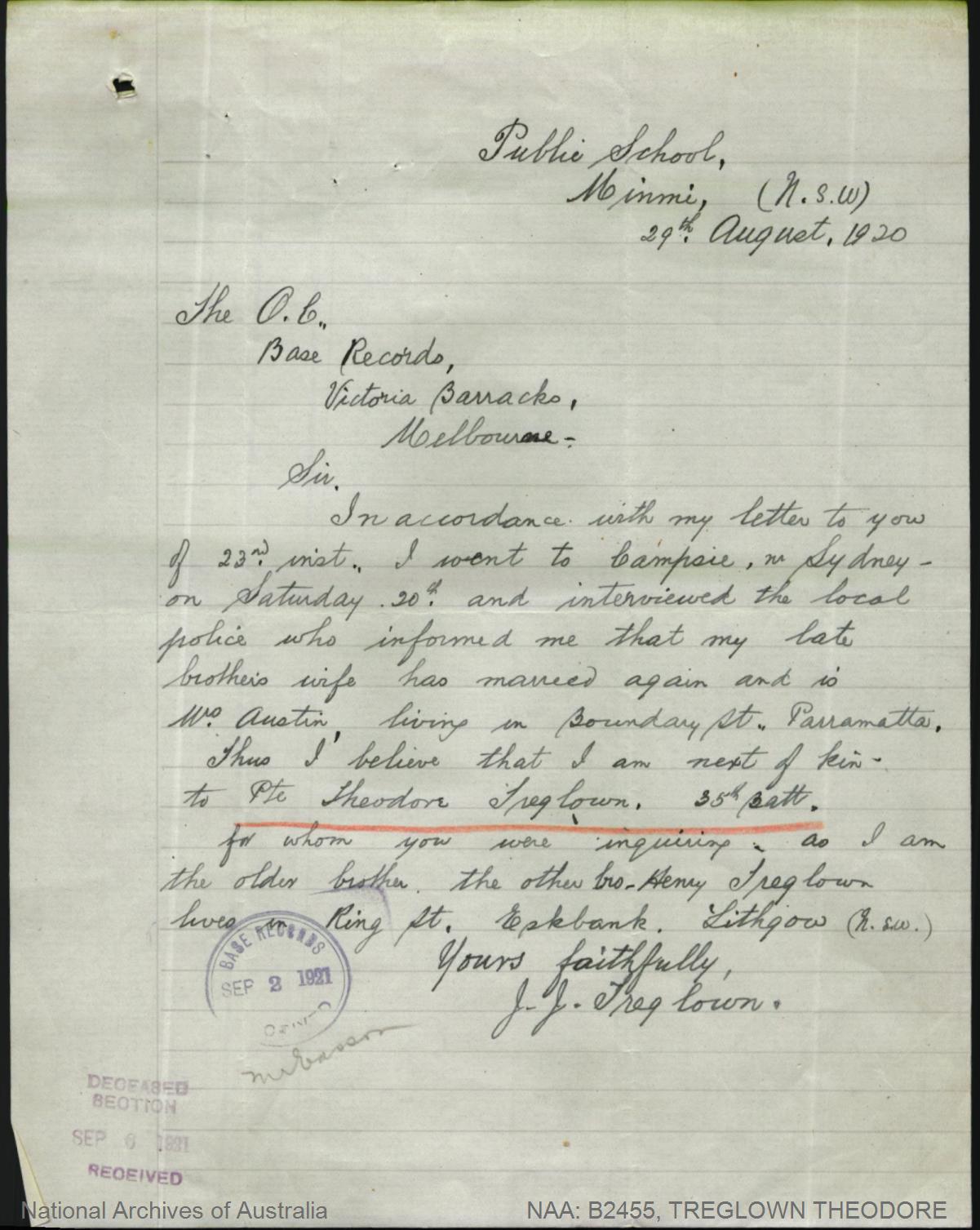
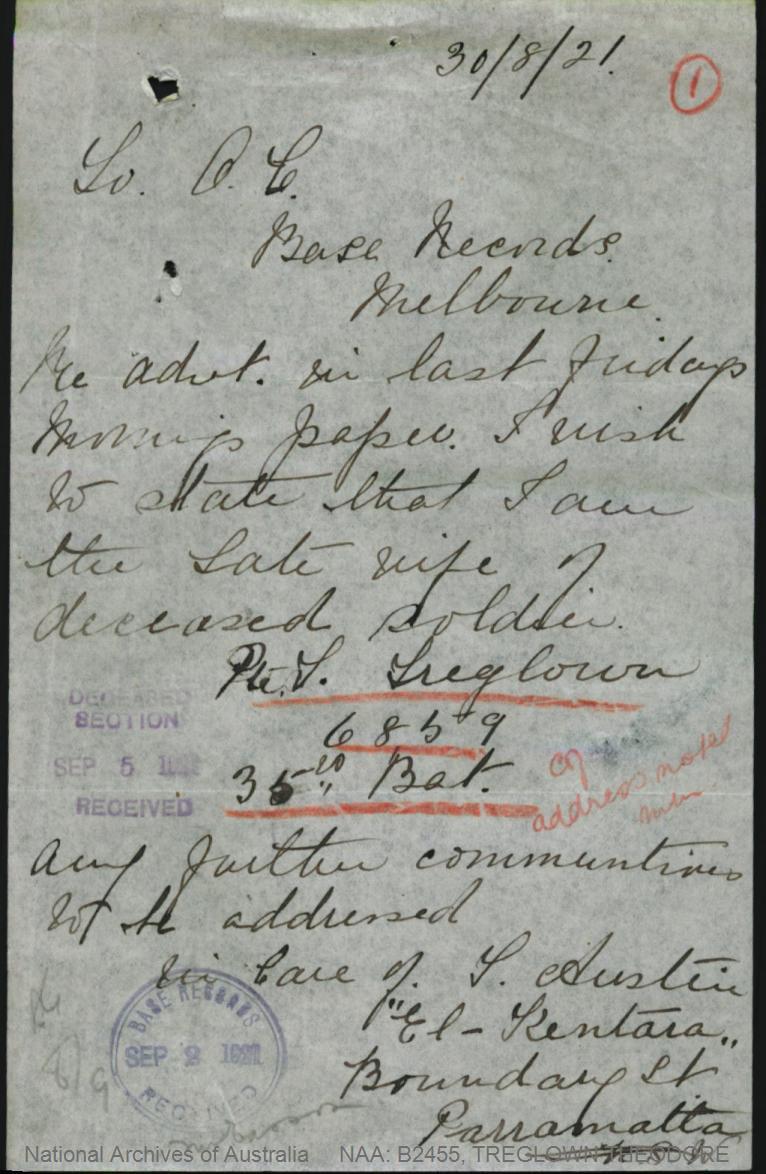
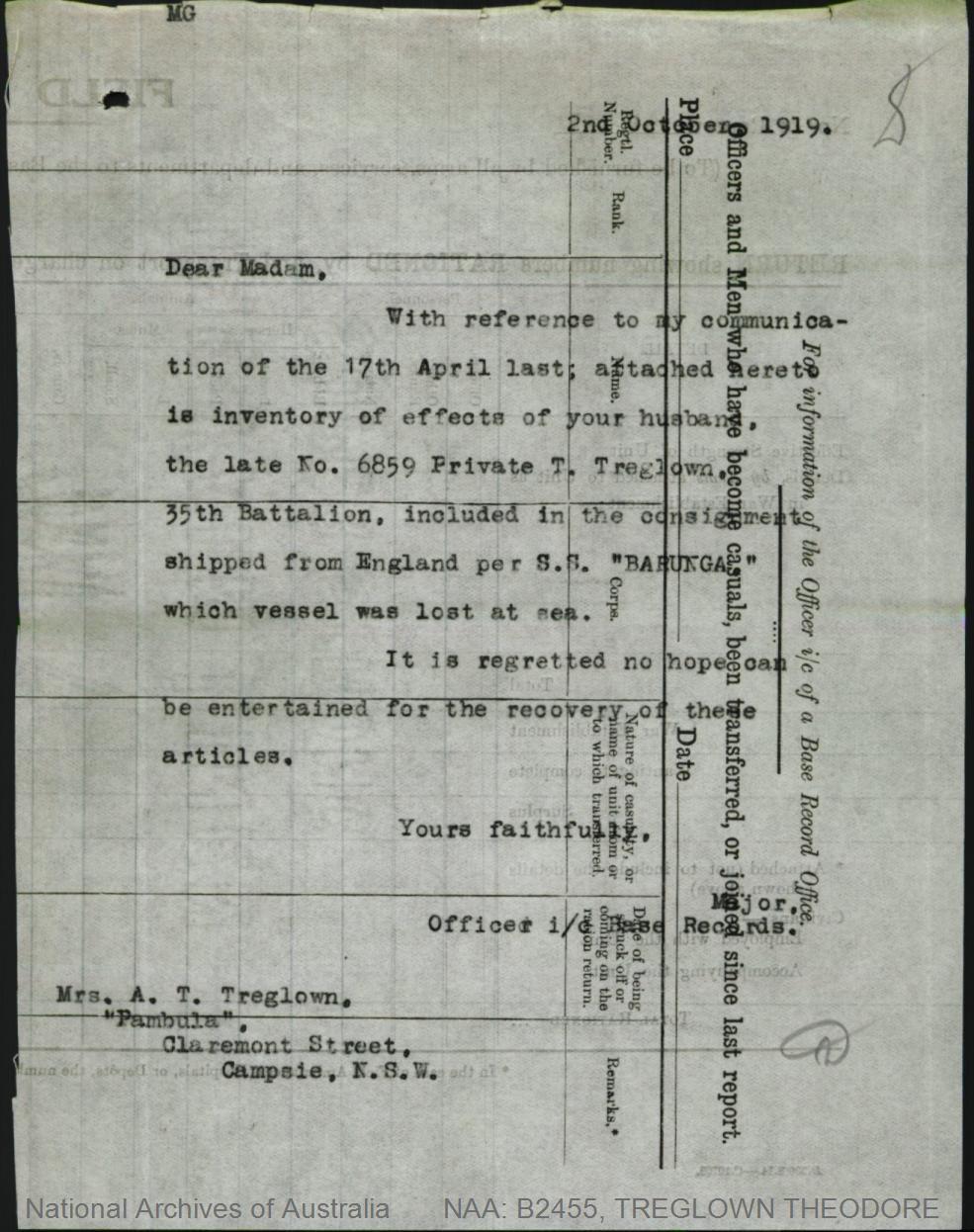
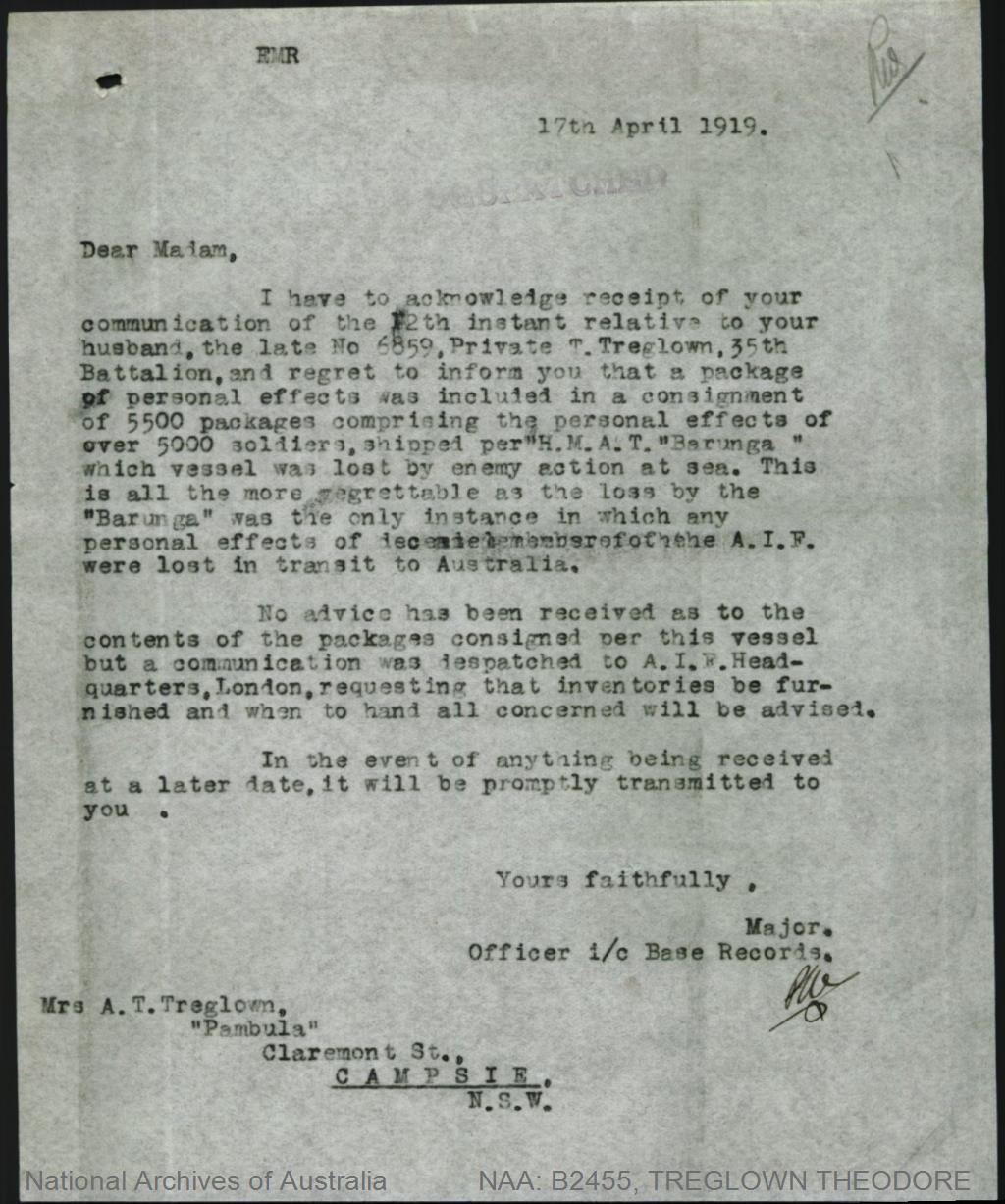
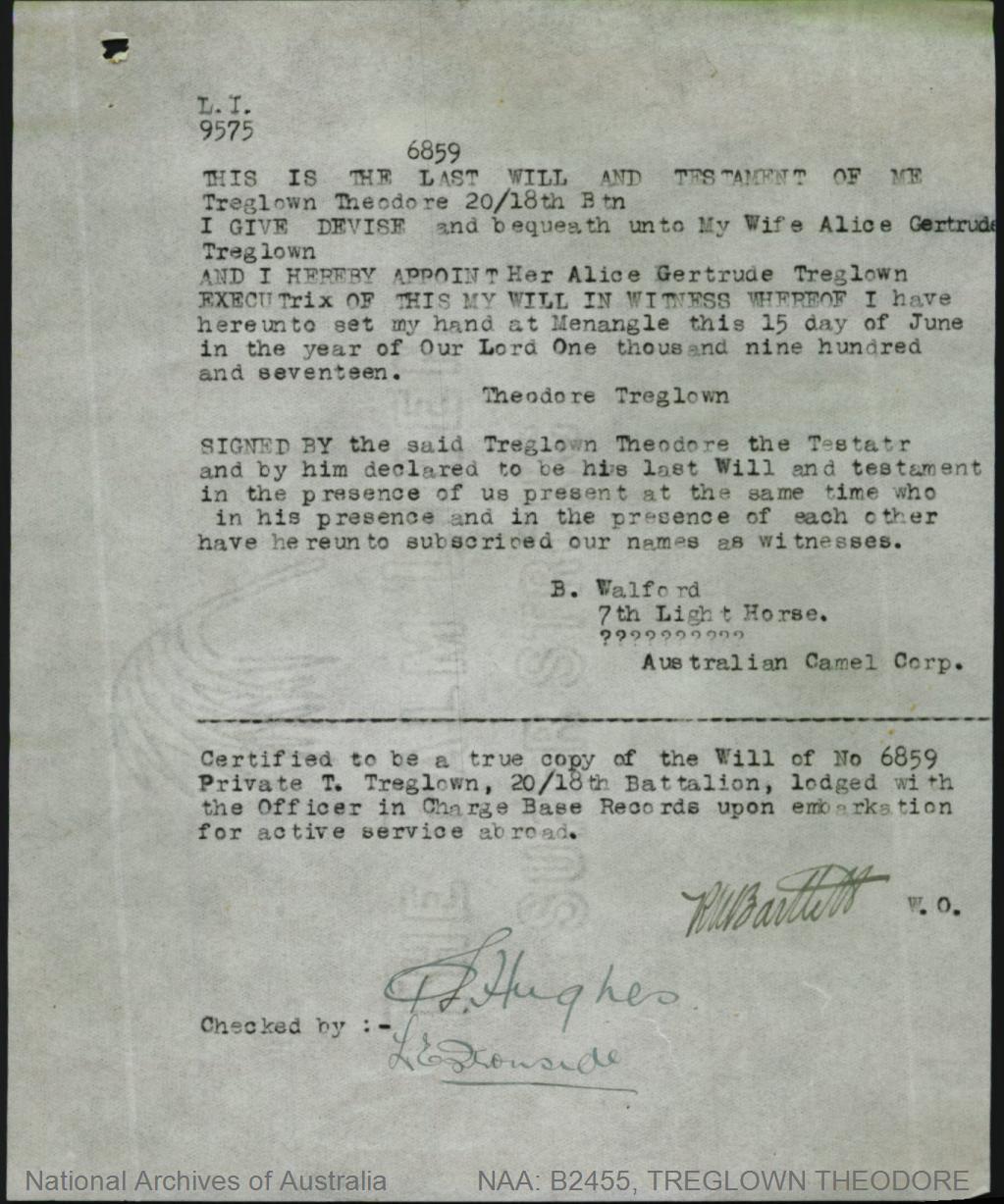
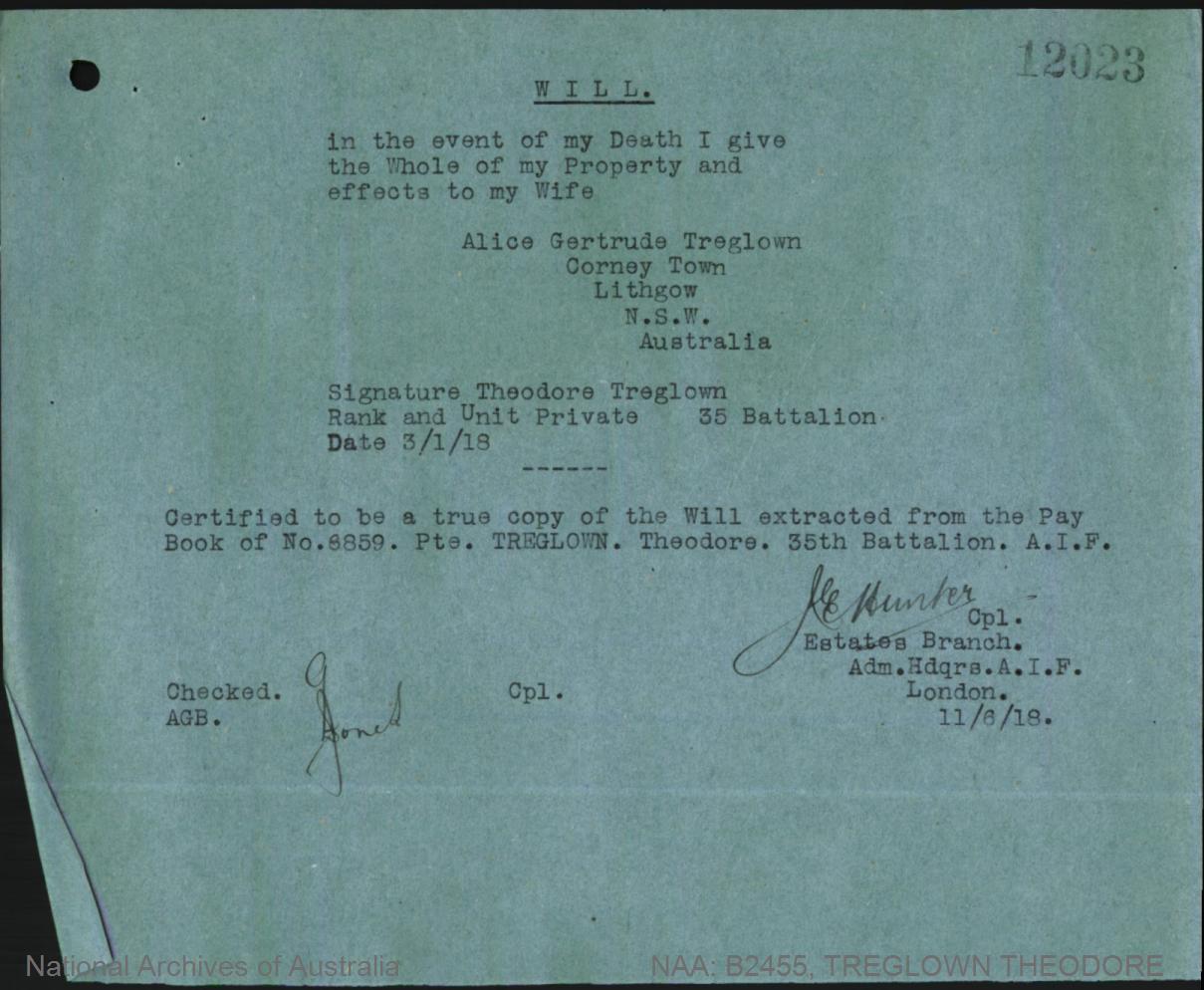
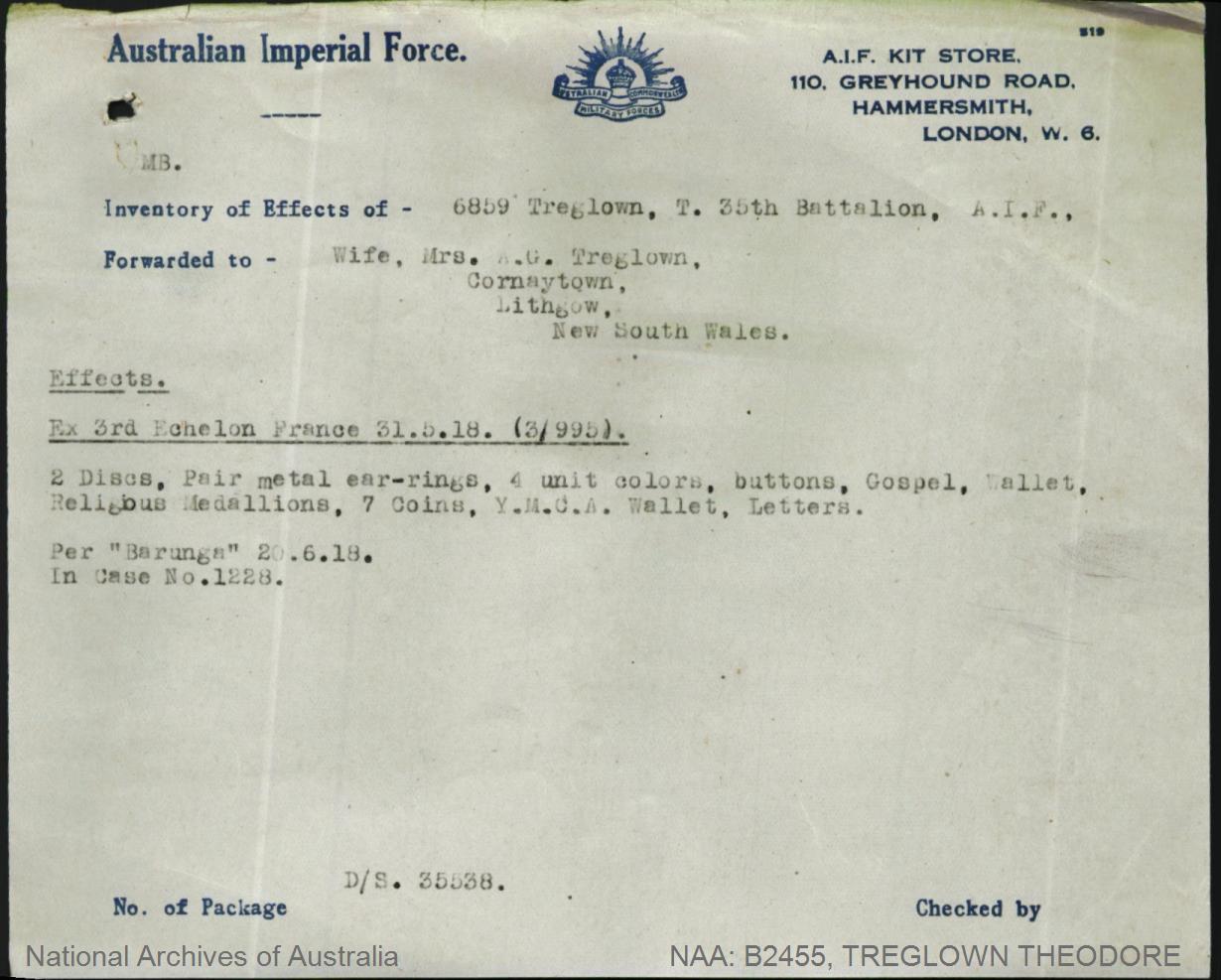


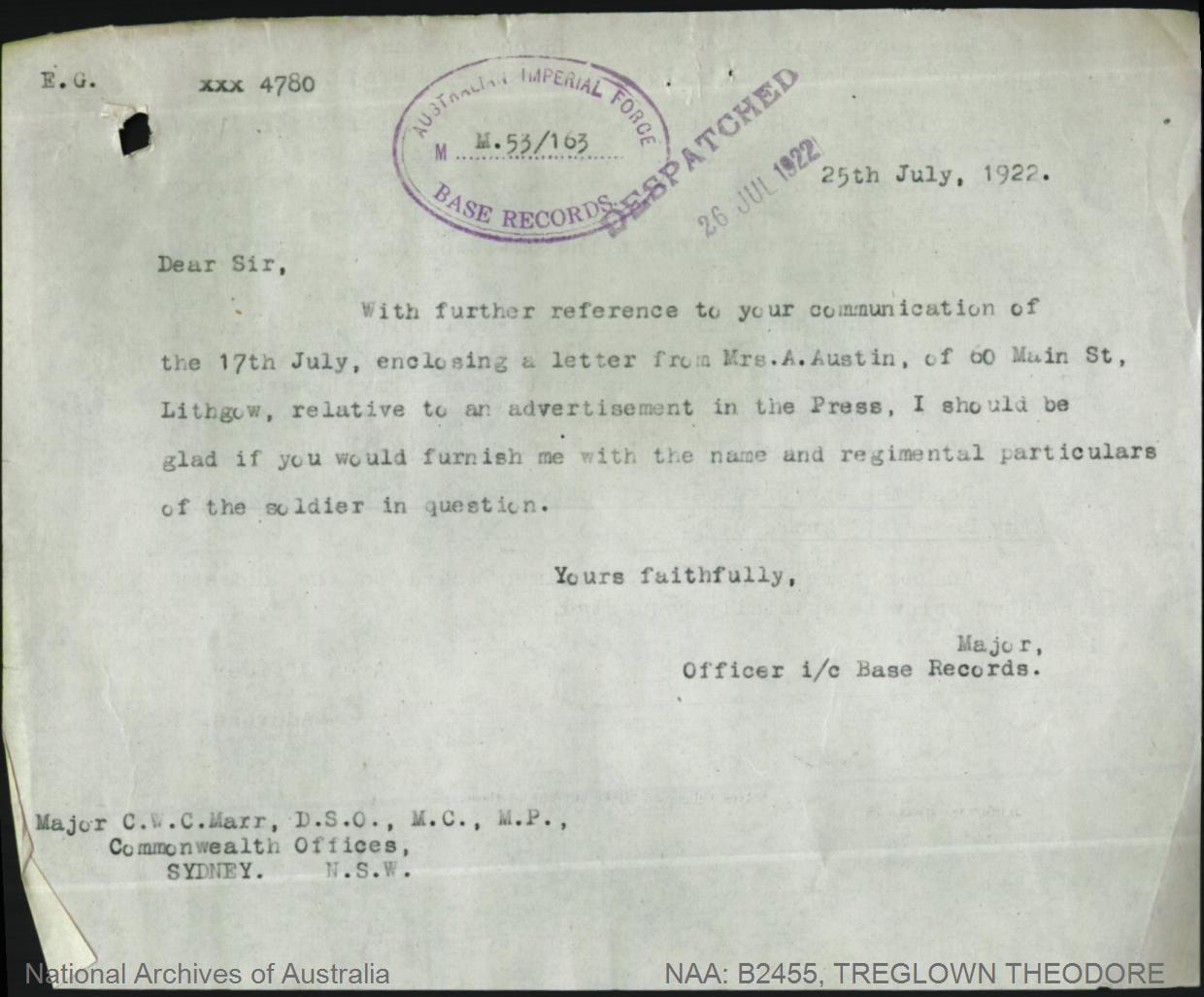
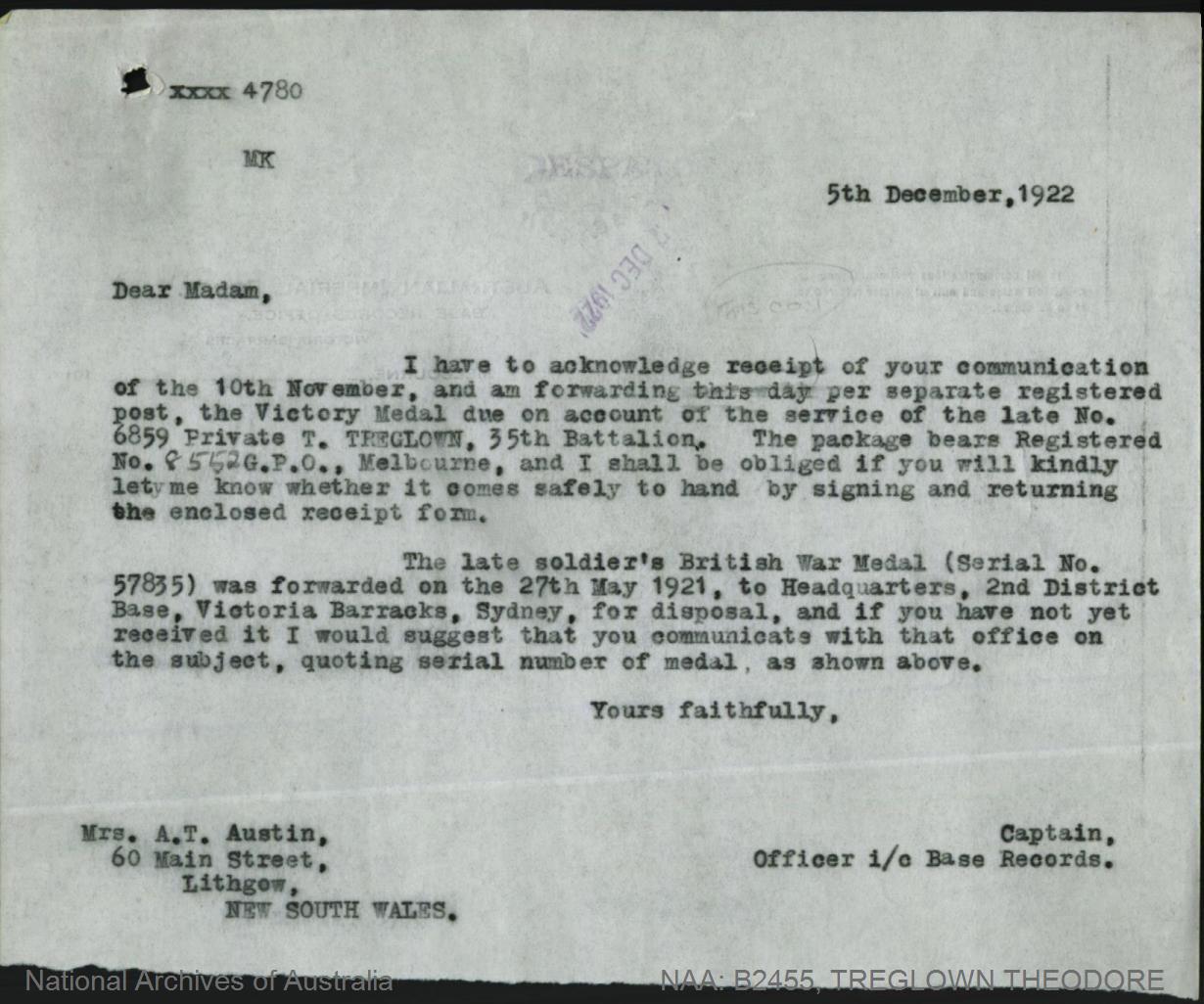
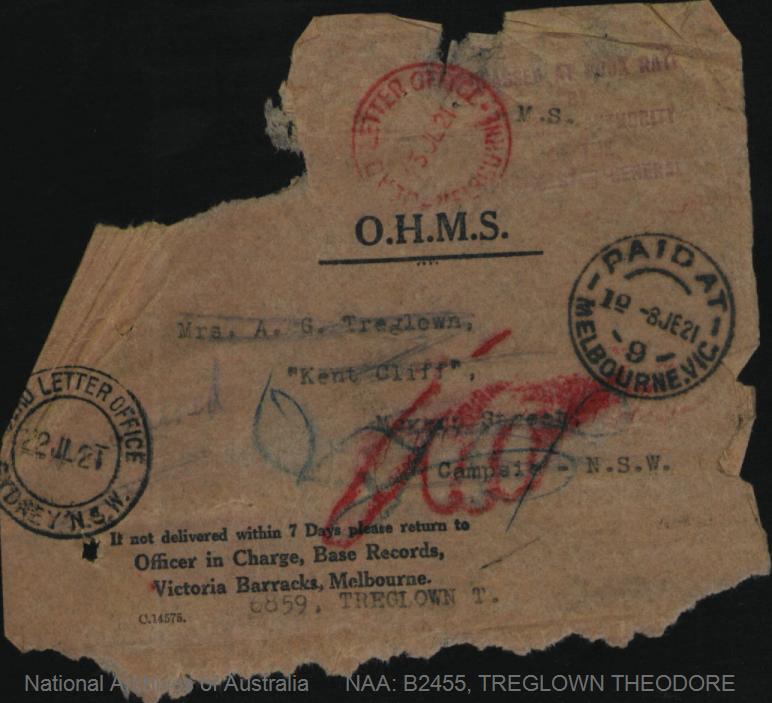


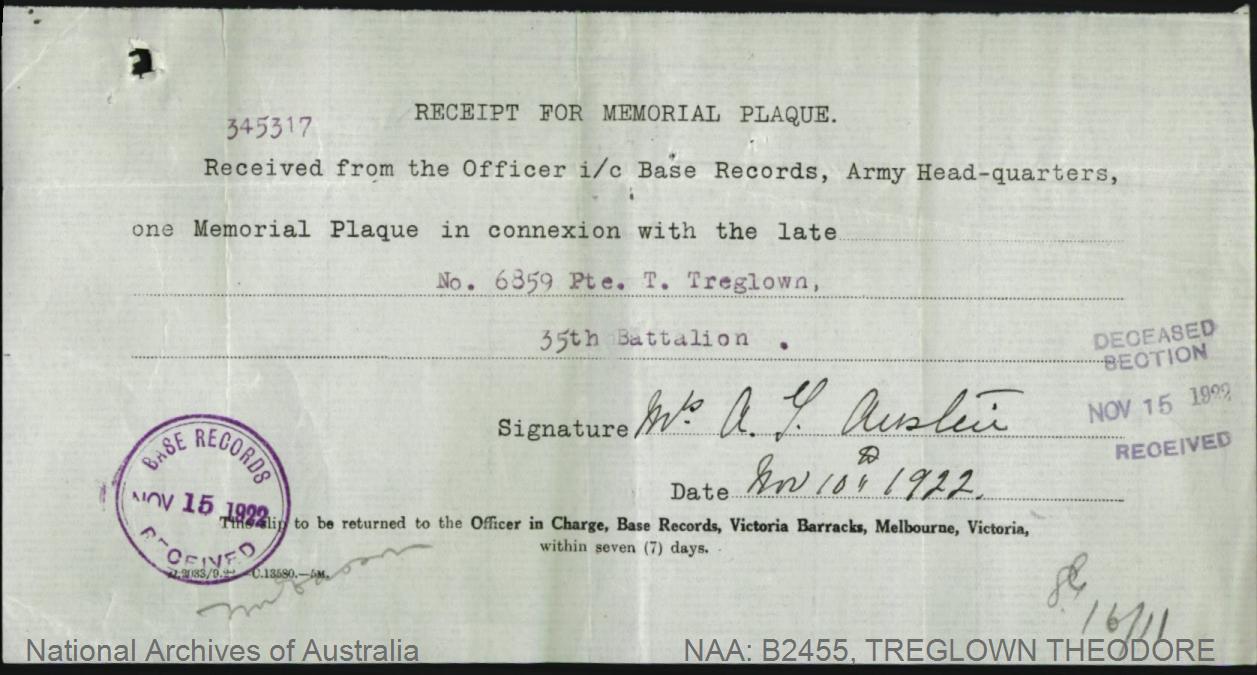
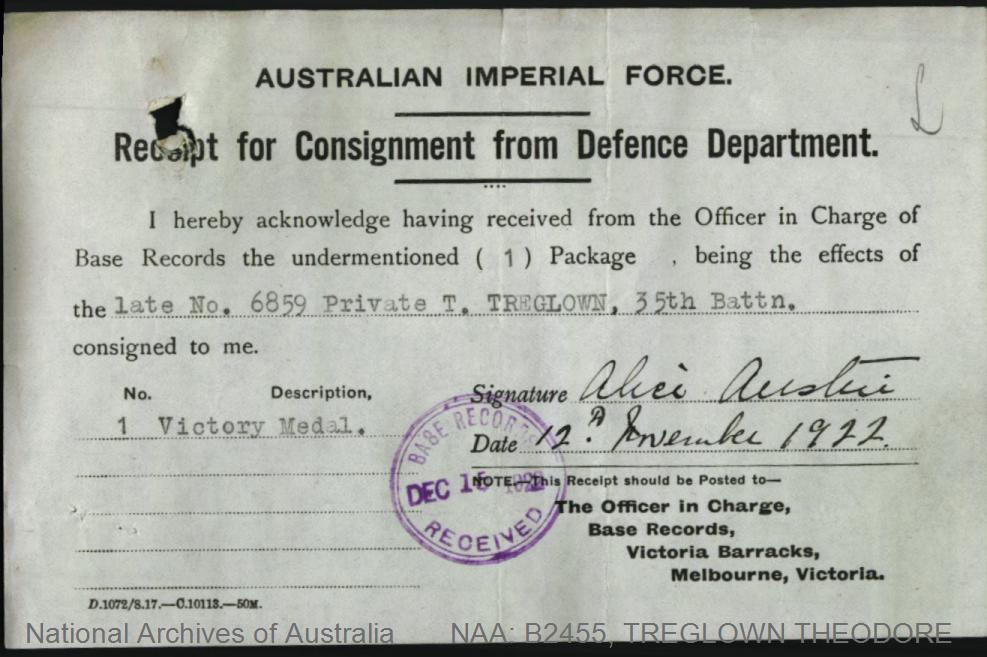
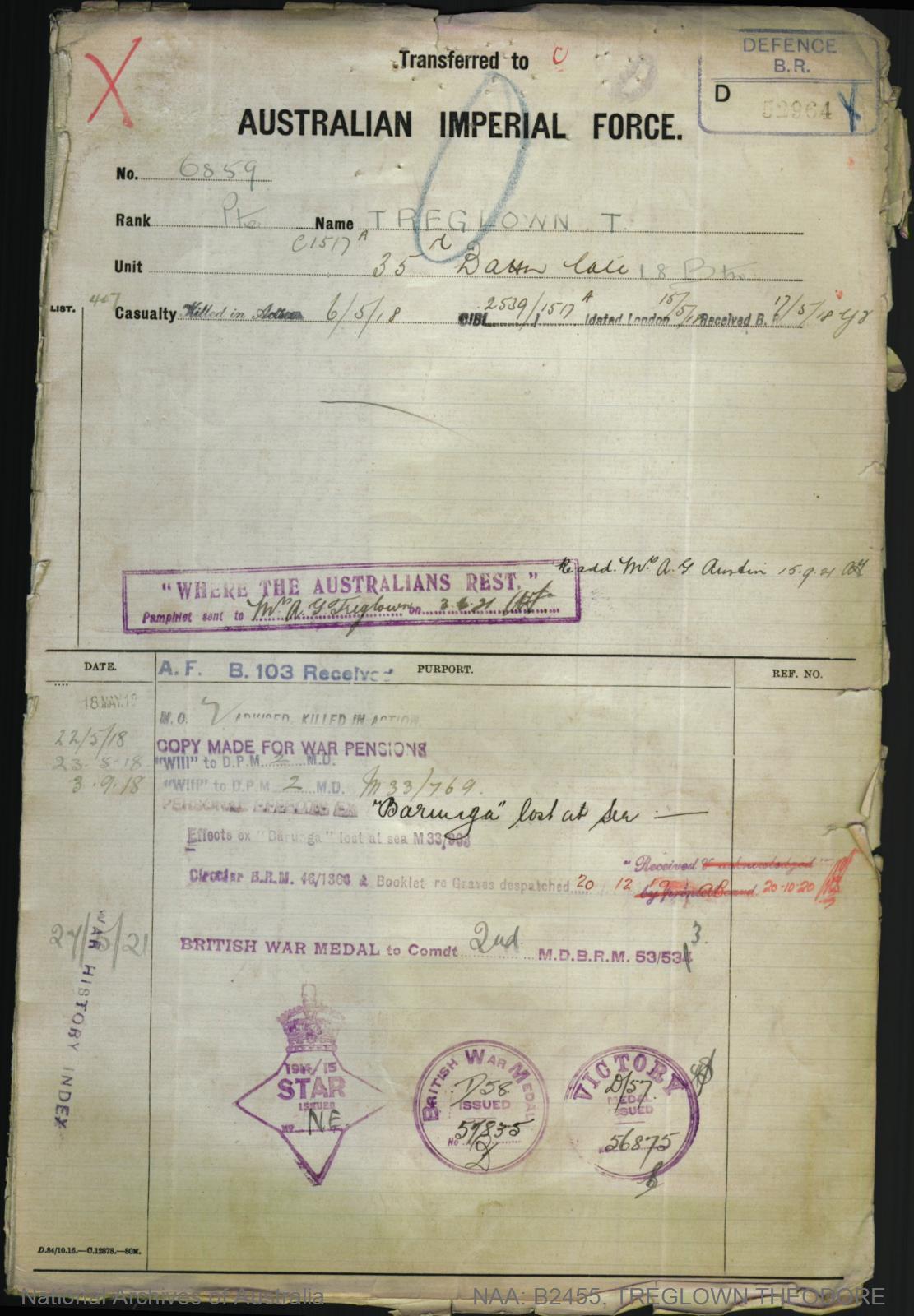

© Commonwealth of Australia (National Archives of Australia)
Under Construction: 25/05/2022-07/06/2022.
